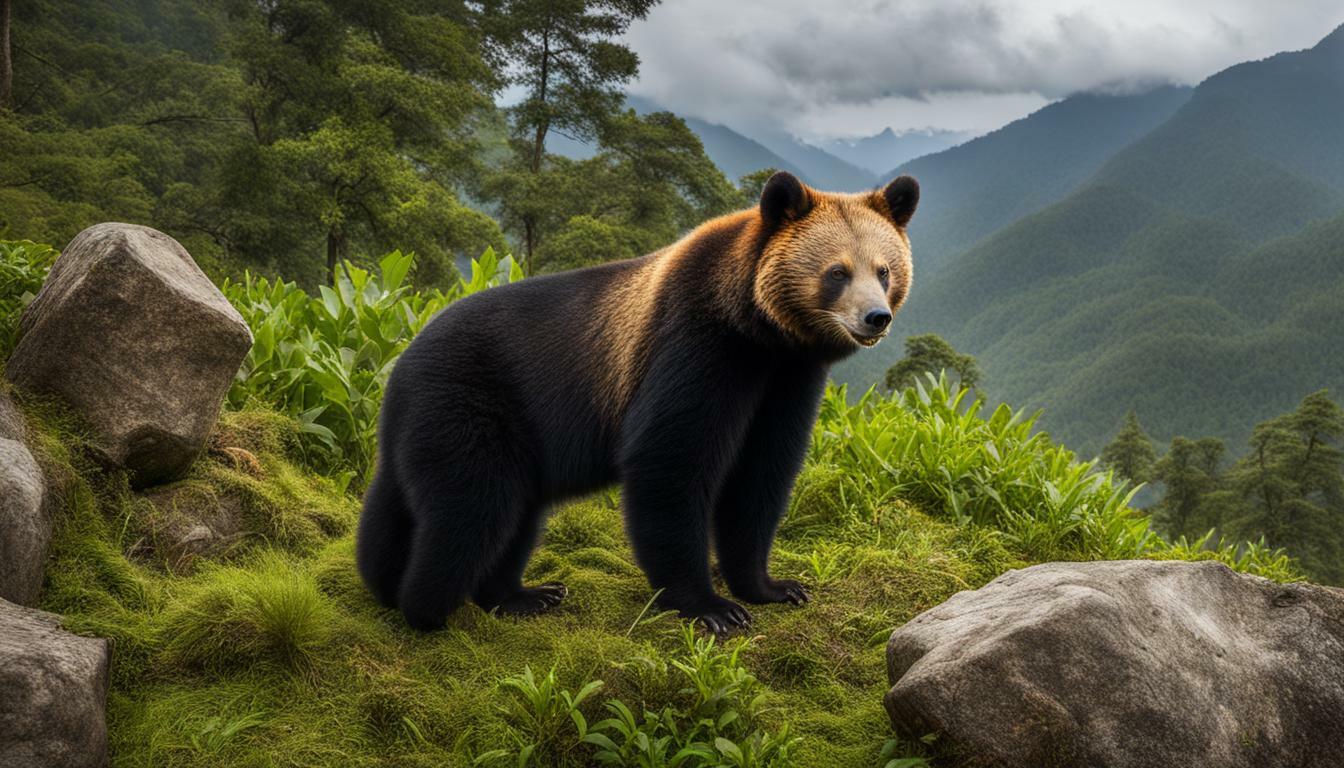Switzerland Biodiversity: Animal and Plant Species and What Is Under Threat
Did you know that Switzerland is home to over 15,000 animal species and 13,000 plant species? This small country boasts a remarkable tapestry of biodiversity, showcasing the richness and diversity of its natural habitats. However, the very biodiversity that makes Switzerland unique is under threat. Climate change, habitat destruction, and pollution are putting immense pressure on Swiss nature preservation and wildlife conservation efforts. It is crucial to address these challenges and prioritize the protection of Switzerland’s precious flora and fauna.
Key Takeaways:
- Switzerland is home to over 15,000 animal species and 13,000 plant species.
- Climate change, habitat destruction, and pollution pose significant threats to Switzerland’s biodiversity.
- Efforts must be made to prioritize nature preservation and wildlife conservation in Switzerland.
- The conservation of Swiss flora and fauna is crucial for the country’s unique ecosystems and the well-being of society.
- Further actions and funding are needed to fully implement biodiversity strategies and protect Switzerland’s biodiversity.
Switzerland’s Protected Areas and Conservation Measures
Switzerland has a long tradition of implementing conservation measures to protect its diverse ecosystems. The country has designated various protected areas, including the National Park, amphibian spawning areas, and dry meadows and pastures, to safeguard its unique biodiversity. However, these protected areas currently cover only around 13.4% of Switzerland’s territory, falling short of the international target of 17% set by the Convention on Biological Diversity.
The Swiss Biodiversity Strategy and its action plan outline comprehensive measures to promote ecological infrastructure, sustainable use of biodiversity, and nature in agglomerations. By prioritizing ecosystem protection and conservation, Switzerland aims to enhance its ecological diversity and ensure long-term environmental sustainability. The strategy emphasizes the importance of maintaining a balance between human activities and nature conservation to preserve the country’s natural habitats and promote Swiss environmental sustainability.
One such measure is the promotion of ecological infrastructure, which involves creating interconnected networks of protected areas, green corridors, and buffer zones. These networks support the movement of wildlife and facilitate genetic exchange, contributing to the overall health and resilience of Swiss ecosystems. Additionally, the strategy emphasizes the sustainable use of biodiversity, encouraging responsible practices that minimize negative impacts on ecosystems while allowing for the utilization of natural resources.
In urban areas, the Swiss Biodiversity Strategy promotes the integration of nature, such as the creation of green spaces and the preservation of local flora and fauna. By considering nature in agglomerations, Switzerland aims to provide residents with access to green areas and enhance their overall well-being.
“The protection and conservation of Switzerland’s diverse ecosystems is crucial for ensuring the long-term survival of its rich biodiversity. By designating and managing protected areas, implementing sustainable practices, and promoting ecological infrastructure, Switzerland can safeguard its natural heritage for future generations.”
| Protected Area | Location | Ecosystem Type |
|---|---|---|
| National Park | Engadine | Alpine |
| Amphibian Spawning Areas | Various regions | Wetlands |
| Dry Meadows and Pastures | Across Switzerland | Grassland |
Switzerland’s Biodiversity Strategy and Action Plan
Switzerland is committed to conserving its unique biodiversity and protecting its natural habitats through the implementation of a comprehensive Biodiversity Strategy and action plan. This strategic framework aims to address the loss of biodiversity and promote the conservation of ecosystem services throughout the country.
The Biodiversity Strategy outlines 10 overarching objectives that guide the conservation efforts in Switzerland. These objectives include direct and indirect promotion of biodiversity, knowledge transfer, and awareness-raising among the public. By focusing on these objectives, Switzerland aims to halt the loss of biodiversity, foster species conservation, and ensure sustainable development.
Efforts under the action plan include the creation and maintenance of protected areas, restoration of degraded habitats, and the promotion of sustainable land use practices. Through these measures, Switzerland aims to create a conducive environment for the preservation of its diverse flora and fauna.
Conservation Measures
Switzerland’s Biodiversity Strategy and action plan employ various measures to achieve its objectives of biodiversity conservation:
- Protection of key natural habitats and ecosystems
- Restoration and enhancement of degraded habitats
- Public education and awareness campaigns
- Sustainable land, water, and resource management
- Promotion of research and knowledge transfer
- Collaboration with international partners
These efforts focus on ensuring the long-term survival of Switzerland’s diverse range of flora and fauna and preserving the natural beauty of the country. However, the successful implementation of the action plan requires increased efforts and adequate funding.
The Urgency of Action
Swiss biodiversity conservation is of paramount importance due to the many benefits it provides. The preservation of natural habitats and the protection of flora and fauna not only contribute to the beauty of Switzerland but also support essential ecosystem services that are vital for human well-being.
“Protecting biodiversity is crucial for maintaining a healthy environment, ensuring sustainable development, and preserving the natural heritage of Switzerland. It is a responsibility we must fulfill for the present and future generations.” – Dr. Marie-Claire Graf, Minister of Environmental Conservation
By implementing the Biodiversity Strategy and action plan, Switzerland aims to safeguard the country’s natural habitats, conserve its unique flora and fauna, and promote sustainable development. Through these concerted efforts, Switzerland is taking a proactive stance in preserving its biodiversity for the benefit of its people and the planet.

Swiss Efforts to Improve Biodiversity in Agriculture and Forests
Swiss agricultural and forest policies play a crucial role in biodiversity conservation. The agricultural policy compensates for services rendered to the general public, including contributions to biodiversity preservation.
Efforts are being made to toughen up criteria for ecological performance in agriculture and reserve cropland for promoting biodiversity. By setting stricter standards, Switzerland aims to ensure that agricultural practices align with the preservation of natural habitats and the protection of Swiss species.
The Forest Policy 2020 takes further steps towards enhancing biodiversity by increasing forest reserves and promoting the growth of deciduous trees. By expanding forest reserves, Switzerland aims to provide more protected areas for various species and improve the ecological diversity within its forests.
However, conserving and promoting biodiversity in agricultural and forested areas require continuous monitoring and sustainable management practices. It is important to strike a balance between economic activities and environmental preservation to create thriving ecosystems that support Swiss wildlife and contribute to the country’s natural heritage.

Importance of Ecological Performance in Agriculture
“We have a shared responsibility to ensure that agricultural practices prioritize the preservation of natural habitats and the protection of our cherished Swiss species. By implementing stricter criteria for ecological performance, we can contribute to the conservation efforts required to maintain Switzerland’s rich biodiversity.”
The Swiss government recognizes the importance of sustainable agriculture in preserving the country’s natural heritage. Through the agricultural policy, farmers are encouraged to adopt environmentally friendly practices, such as organic farming and habitat preservation, to support Swiss species preservation.
Enhancing Forest Reserves for Biodiversity
“Expanding our forest reserves and promoting the growth of deciduous trees are integral steps in our Forest Policy 2020. By doing so, we aim to create diverse forest ecosystems that provide habitats for various species and contribute to the preservation of Switzerland’s unique biodiversity.”
The Forest Policy 2020 focuses on increasing the percentage of forest reserves and encouraging the planting of deciduous trees. These actions aim to create a more diverse forest ecosystem, allowing for a greater variety of plants and animals to thrive in Switzerland’s forests.
- Forest reserves provide protected areas for species to breed, feed, and shelter.
- Deciduous trees enhance biodiversity by providing different habitats and food sources for wildlife.
Switzerland’s dedication to improving biodiversity in agriculture and forests not only benefits wildlife but also ensures the long-term health of its ecosystems. By implementing sustainable practices and monitoring conservation efforts, Switzerland continues to lead in nature preservation and Swiss species conservation.
Impact of Climate Change on Switzerland’s Biodiversity
Climate change poses significant threats to Switzerland’s biodiversity. The Alps, home to rich biodiversity, are particularly vulnerable to the effects of warming temperatures. Species in these regions may become extinct if temperature increases exceed certain thresholds.
Climate change also impacts the treeline, with evidence of upward shifts, changes in plant distribution, and potential competition among species. These changes have the potential to disrupt ecosystems and lead to the loss of valuable biodiversity.
“Climate change is a global crisis that demands urgent action. In Switzerland, we are witnessing the impacts of rising temperatures on our unique ecosystems. We must act now to protect our biodiversity for future generations.”
To mitigate the effects of climate change on Switzerland’s biodiversity, it is crucial to understand the specific vulnerabilities of different species and ecosystems. This knowledge can inform conservation strategies and help prioritize efforts to conserve the most at-risk species and habitats.

The Alps: A Hotspot of Biodiversity
The Alps are not only a popular tourist destination but also a biodiversity hotspot. They support a wide range of plant and animal species, many of which are adapted to specific alpine conditions. However, as temperatures continue to rise, these species face significant challenges.
- Warmer temperatures can disrupt the delicate balance between species, leading to increased competition for resources and potential loss of biodiversity.
- Changes in snowfall patterns can affect the timing of plant growth and reproduction, impacting the entire alpine ecosystem.
- The shrinking of glaciers and loss of snow cover can have cascading effects on water availability and habitat suitability for a wide range of species.
Protecting the unique biodiversity of the Alps requires integrated approaches that consider not only the direct impacts of climate change but also the indirect effects on ecosystems and their interdependencies.
Changing Treelines and Species Distribution
Climate change also influences the distribution and composition of plant and animal species in Switzerland. One noticeable effect is the upward shift in the treeline, the natural boundary where forests transition into alpine meadows.
- As temperatures increase, trees are gradually colonizing higher elevations, altering the composition of montane and alpine ecosystems.
- This upward shift can lead to changes in the availability of suitable habitats for certain species, potentially leading to the displacement or extinction of species adapted to specific climatic conditions.
- Increased competition between lowland and highland species can further disrupt ecological dynamics and affect overall biodiversity.
Understanding and monitoring these changes in species distribution is critical for effective conservation planning and the preservation of Switzerland’s ecological diversity.
By taking proactive measures to reduce carbon emissions, promote sustainable land use practices, and protect vulnerable habitats, Switzerland can contribute to global efforts to combat climate change and safeguard its unique biodiversity for future generations.
Freshwater and Wetlands Biodiversity Challenges in Switzerland
Switzerland’s freshwater ecosystems and wetlands are facing numerous challenges that threaten the country’s biodiversity and natural habitats. Changes in water temperature, precipitation patterns, and ice cover have significant impacts on the delicate balance of these ecosystems.
Rising temperatures have already surpassed the acceptable limits for some species of trout in Swiss rivers. As water temperatures increase, it becomes increasingly difficult for these species to survive and reproduce, putting their populations at risk.
The North Atlantic Oscillation, a meteorological phenomenon influenced by climate change, has also been affecting water temperatures and ice cover in lakes across Switzerland. These changes have far-reaching consequences for aquatic ecosystems and the species that depend on them for survival.
However, the challenges do not end there. Water pollution, nutrient deposition, and invasive alien species further threaten the integrity of Switzerland’s inland water ecosystems. These factors disrupt the delicate balance of the ecosystem, negatively impacting native species and reducing biodiversity.

Protecting and conserving Switzerland’s freshwater biodiversity is crucial to maintain the health of these ecosystems and preserve the country’s natural heritage. Efforts should focus on reducing pollution, controlling invasive species, and implementing sustainable management practices.
Polluted waters and invasive species endanger the delicate balance of Switzerland’s freshwater ecosystems. It is our responsibility to protect and conserve these invaluable habitats.
Conservation measures should encompass a holistic approach that considers the interconnectedness of land, water, and species. By safeguarding freshwater ecosystems and wetlands, we contribute to the preservation of Switzerland’s unique biodiversity and ensure a sustainable future for generations to come.
Extinction Debt of High-Mountain Plants in Switzerland
High-mountain plants in Switzerland face the risk of extinction due to climate change. Static and hybrid models predict significant range reductions for alpine plants by the end of the 21st century. The hybrid model suggests that persisting remnant populations under unsuitable climatic conditions may create an extinction debt.
Genetic adaptation and conservation efforts are crucial to ensure the survival of high-mountain plant species in Switzerland.
Alpine Plant Range Reductions
According to static and hybrid models, climate change will lead to substantial range reductions for alpine plants in Switzerland. These models project that by the end of the 21st century, many high-mountain plant species will experience a decline in suitable climatic conditions for their survival. As a result, their distribution will be restricted to smaller areas, putting them at risk of extinction.
“The hybrid model shows the potential for an extinction debt among high-mountain plant populations. It suggests that even if some populations manage to persist in unsuitable habitats, they may eventually go extinct due to the inability to adapt to changing environmental conditions.”
The Importance of Genetic Adaptation
Genetic adaptation plays a crucial role in the survival and resilience of high-mountain plants. It enables species to adapt to changing environmental conditions and ensures their long-term viability. Through genetic variation and natural selection, plant populations can evolve traits that allow them to cope with the challenges posed by climate change.
Conservation Efforts
Conservation efforts are essential to protect high-mountain plant species in Switzerland. Measures such as habitat restoration, seed banking, and reintroduction programs can aid in preserving genetic diversity and enhancing the resilience of these plants. Additionally, raising awareness about the importance of these species and their role in maintaining Swiss ecological diversity is crucial for garnering support for conservation initiatives.
Preserving Switzerland’s Ecological Diversity
Preserving Switzerland’s ecological diversity is of utmost importance to maintain the health and balance of its ecosystems. Protecting high-mountain plants from the threats posed by climate change is a vital step in ensuring the long-term sustainability of Swiss biodiversity. By implementing effective conservation strategies and promoting genetic adaptation, Switzerland can work towards safeguarding its unique plant species and preserving the ecological richness of its high-mountain regions.

Biodiversity in Swiss Landscapes and its Relationship with Land Use
Land use practices significantly influence biodiversity in Swiss landscapes. Intensive agriculture, urbanization, and forest coverage impact the diversity of flora and fauna. While agricultural practices have led to a decline in genetic diversity, organic farming has seen a steady increase. Forests, despite their growth, have only a small percentage of protected areas. Sustainable forest management and balanced land use practices can promote biodiversity conservation in Swiss landscapes.
Influence of Land Use Practices on Biodiversity
The diverse landscapes of Switzerland are shaped by various land use practices that directly impact the richness of its flora and fauna. Intensive agricultural practices, which involve the use of pesticides and high-yield crop varieties, have resulted in a decline in genetic diversity among plant species (Swiss nature preservation). This reduction in genetic diversity can have long-term negative consequences for the resilience and adaptability of these species in the face of environmental challenges (Swiss ecological diversity).
Urbanization, with its expanding infrastructure and construction projects, also contributes to the loss of natural habitats and fragmentation of ecosystems. This fragmentation disrupts the natural movement and gene flow of wildlife populations, reducing their viability and increasing the risk of local extinctions (Swiss wildlife conservation).
Forest coverage in Switzerland has been increasing over the years, thanks to reforestation efforts and natural regeneration. However, the percentage of protected areas within these forests is relatively low (Swiss nature preservation). This lack of protection poses a risk to the diverse range of species that rely on forested habitats for survival and reproduction (Swiss ecological diversity).
Organic Farming as a Sustainable Alternative
Organic farming practices, which prioritize environmental sustainability and the use of natural fertilizers and pest control methods, have shown promise in promoting biodiversity conservation in Swiss landscapes (Swiss wildlife conservation). By avoiding the use of synthetic chemicals, organic farming creates a more favorable environment for beneficial insects, soil microorganisms, and other organisms that contribute to ecosystem health (Swiss ecological diversity).
Organic farms also tend to have a greater variety of plant species, providing habitats for a wider range of pollinators and other wildlife (Swiss nature preservation). This diversity not only supports the survival of these species but also enhances the resilience of agricultural systems to climate change and other environmental pressures (Swiss ecological diversity).
Sustainable Forest Management for Biodiversity Conservation
Ensuring sustainable forest management practices is essential for preserving the biodiversity found within Switzerland’s forests (Swiss nature preservation). This includes maintaining a balance between the extraction of timber and the conservation of natural habitats, as well as promoting the growth of different tree species to increase biodiversity (Swiss wildlife conservation).
Sustainable forest practices also involve preserving deadwood, which provides important habitats for various organisms, including fungi, insects, and small mammals (Swiss ecological diversity). Additionally, creating forest corridors and connecting fragmented habitats can improve the movement and gene flow of wildlife populations, promoting genetic diversity and resilience (Swiss wildlife conservation).
Comparing Land Use Practices and their Impact on Biodiversity
| Land Use Practice | Impact on Biodiversity |
|---|---|
| Intensive Agriculture | Decline in genetic diversity of plant species |
| Urbanization | Loss of natural habitats and fragmentation of ecosystems |
| Organic Farming | Promotes biodiversity through a variety of plant species and natural farming methods |
| Sustainable Forest Management | Preservation of diverse habitats and improvement of wildlife movement and gene flow |
By promoting sustainable land use practices, Switzerland can enhance its nature preservation and wildlife conservation efforts, safeguarding its ecological diversity for future generations to enjoy.

The Importance of Biodiversity for Ecosystem Services and Society
Biodiversity plays a crucial role in providing essential ecosystem services that benefit both society and the environment. In Switzerland, the preservation of biodiversity is vital for promoting Swiss environmental sustainability, conserving Swiss biodiversity, and protecting Switzerland’s natural habitats.
One of the key ecosystem services provided by biodiversity is food production. The diverse range of plant and animal species contributes to a resilient and sustainable agricultural system. Pollinators, such as honeybees, play a crucial role in crop pollination, ensuring the production of fruits, vegetables, and other agricultural products. By valuing and protecting biodiversity, Switzerland can continue to sustain its food production systems and support its economy.
Genetic resources are another important ecosystem service provided by biodiversity. Switzerland’s rich biodiversity acts as a genetic reservoir, containing valuable genetic information that can be used for various purposes, including medical research, the development of new crop varieties, and the conservation of endangered species. Preserving biodiversity ensures the availability of these genetic resources for present and future generations.
Biodiversity also plays a vital role in water purification and soil fertility. Healthy ecosystems, such as forests and wetlands, act as natural filters, cleansing water by trapping pollutants and sediment. This helps in maintaining water quality, ensuring a sustainable water supply for both human consumption and the environment. Additionally, diverse plant communities improve soil fertility by enhancing nutrient cycling and preventing soil erosion, contributing to sustainable agricultural practices.
Forests, in particular, have multiple ecological functions that benefit society. They act as vital carbon sinks, helping to mitigate climate change by absorbing and storing carbon dioxide from the atmosphere. Forests also play a crucial role in regulating water cycles, preventing soil erosion, and mitigating natural hazards such as landslides and flooding. Moreover, forests are important for Switzerland’s tourism industry, attracting nature enthusiasts and providing recreational opportunities.
“Biodiversity is not just a scientific concept; it is a reality that sustains life on Earth.” – Sir David Attenborough
Recognizing and valuing the importance of biodiversity and ecosystem services are crucial for sustainable development in Switzerland. By integrating biodiversity conservation into policies, promoting sustainable land use practices, and raising public awareness, Switzerland can ensure the continued provision of essential ecosystem services and preserve its natural heritage for future generations.
Table:
| Ecosystem Service | Benefits |
|---|---|
| Food production | Diverse plant and animal species support sustainable agriculture and pollination |
| Genetic resources | Valuable genetic information for medical research, crop development, and species conservation |
| Water purification | Healthy ecosystems act as natural filters, improving water quality |
| Soil fertility | Diverse plant communities enhance nutrient cycling and prevent soil erosion |
| Forests | Carbon storage, water regulation, natural hazard prevention, and tourism |
By embracing the importance of biodiversity and working towards Swiss environmental sustainability and Swiss biodiversity conservation, Switzerland can continue to protect its natural habitats and ensure a harmonious coexistence between society and the environment.

Conclusion
Switzerland’s biodiversity is at risk due to climate change, habitat destruction, and human activities. However, the country has taken significant steps towards conservation by implementing measures, establishing protected areas, and developing biodiversity strategies.
To ensure the long-term health of its ecosystems, Switzerland must continue to prioritize nature preservation, wildlife conservation, and sustainable land use practices. Further actions are required to fully implement these initiatives and secure adequate funding for effective biodiversity conservation.
Protecting the unique biodiversity and ecological diversity of Switzerland is crucial for maintaining the balance of its ecosystems and preserving the natural heritage of the country. By investing in these efforts, Switzerland can safeguard its wildlife and contribute to the global conservation of biodiversity for future generations to enjoy.








